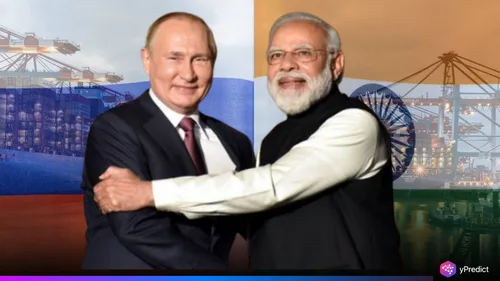
India and Russia are looking to bolster their ties with a long-standing economic relationship and a target that is very ambitious. The countries plan to increase their annual trade by approximately 50 percent over the subsequent five-year period to $100 billion. The two economies are continuing their efforts as both nations are trying to strengthen bilateral ties and are looking to reduce their reliance on Western countries.
While seemingly straightforward, the plan means more than just the number. The plan indicates deeper ties between the two as both nations continue to experience rising uncertainty in the world markets. With increasing geopolitical frictions, especially with the U.S., the two countries want to try and solidify their economic foundation. Leaders on both sides think that greater trade will balance their strategic needs with new economic opportunities for businesses in many sectors.
Aiming to emphasize a wider agenda of trade diversification, the partners want to focus on tariff reduction, simplified processes, and better access to markets; all sectors, not just energy and defense. The partners see trade diversification as the path to greater stability and sustained growth. The renewed emphasis on India Russia trade establishes the partnership as a direct counterbalancing effect to bestowed Western economic pressure.
Why India and Russia Want Faster Trade Expansion
The target of $100 billion is about much more than a number. For India, this means greater access to Russian resources that can help improve its energy security and decrease the cost of imports. For Russia, India represents a significant market for goods and technology at a moment when Western sanctions are straining the economy.
Both countries are in agreement that tariff reduction is key to bilateral trade growth. Tariff reductions placed a spotlight on the potential for increased agricultural products, technology, pharmaceuticals, and industrial goods exports. A more balanced mix of goods can help decrease reliance on energy, which dominates the current bilateral trade flows.
Both countries will pursue implementing a more balanced trade architecture less susceptible to shocks from the global energies market. This evolving architecture reflects an emerging desire to organize trade around long-term strategic needs rather than short-term cycles of demand.
The Geopolitical Context Driving Trade Goals
The timing of trade initiative is crucial. Russia is under tremendous economic limitations from the US and the allies and looking to Asian markets for the future of its economy. India has experienced its share of trade conflict with the US and has been developing relationships with other business partners. Joining in expanding India Russia trade, both countries aim to reduce dependence on unilateral sanctions and the political uncertainty of one country allowing trade and not another. It also allows Russia to export products to a stable growing market, while giving India easy access to reliable suppliers of staple products.
This relationship also implies a move away from traditional norms of global trade were countries choose trade partners based solely on the convenience of commerce as economy permits, while showing how trade growth can mitigate geopolitical tension.
Key Sectors Expected to Drive Trade Expansion
Energy will continue to be a core element in the partnership, however, both countries are ambitious to go further. There are key areas identified for expansion like agriculture, technology, defense manufacturing, and pharmaceuticals. All of which meet domestic needs and are aligned to export goals for both sides.
Russia has ambitions to export more fertilizers, minerals, and industrial products and, India plans to export more machinery, IT services, and medicines. While these areas are just as exciting, tariff reductions previously mentioned will eventually lower costs for business and contribute to a lower cost of doing business in general, making it more stimulating for all governments and private enterprises.
This focus creates diversification to the $100 billion goal that is comprised of many industries – not just energy. This creates room for sustainable growth and less vulnerability to commodity price volatility.
Strengthening Long-Term Economic Relations
The goal of $100 billion in trade is also about building better institutional structures in general. India and Russia are also developing new payment mechanisms, investment treaties, and regulatory cooperation. These initial efforts are to help bilateral trade expansion be more predictable, as they will be less susceptible to currency and policy risk, significantly ahead business level transactions.
Both governments are also conducting logistical assessments around shipping routes and customs clearance, and hopefully an easier/or cheaper means of trade participation will encourage private sector engagement.
The partnership reflects how both countries are rereading and rethinking their economic policies on a world where allegiances are not permanent but strategic. It illustrates that India Russia trade goes beyond defense and energy; and is working toward a comprehensive economic future.
Final Thoughts on the $100 Billion Goal
It is both bold and strategic, as well as necessary, that India and Russia hope to expand trade 50 percent over five years. The target itself demonstrates the ambition shared by both nations to adapt to changing global conditions while decreasing relationships with Western partners. Both countries will need to reduce tariffs, as well as expand industry options.
With both nations moving ahead, the partnership will yield more opportunities for businesses, investors and consumers. The expansion of commerce between India and Russia is also a reminder that worldwide trade is shifting to more diversified strategic relations.







